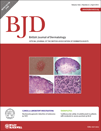Changes in the nail unit in patients with secondary lymphoedema identified using clinical, dermoscopic and ultrasound examination
Funding sourcesNone.
Conflicts of interestNone declared.
Summary
Background Secondary lymphoedema is characterized by lymphatic stasis that is often the result of a lymph node lesion. At advanced stages it may cause trophic changes in the skin. However, the presence of changes in the nail unit has not been reported to date.
Objectives The aim of this study was to determine the presence of nail abnormalities in cases of secondary lymphoedema.
Methods This was a prospective study, conducted on patients with unilateral secondary lymphoedema. A comparative clinical and dermoscopic examination and 20-MHz high-resolution ultrasound imaging of the affected limb and the contralateral limb were performed.
Results Thirty-three patients were included. On physical examination, hyperkeratosis of the lateral nail folds, friability of the nail surface, ‘ragged’ proximal nail folds and cuticle and apparent leuconychia were observed more frequently on the lymphoedematous limb. The ultrasound study of the nails of the thumb and the big toe did not reveal any differences in thickness of the different structures of the nail between the lymphoedema side and the opposite side. The nail matrix was longer on the lymphoedema side.
Conclusions Our study showed mild changes in the nail unit compatible with the xerosis often associated with severe lymphoedema. However, the study also showed frequent evidence of ‘ragged’ cuticles, which in these patients at high risk of erysipelas are entry points for bacteria. This should be taken into account when counselling patients with limb lymphoedema in order to prevent erysipelas.




